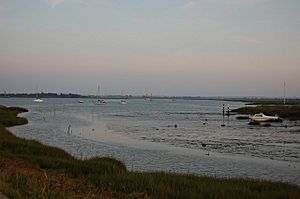Blackwater Estuary facts for kids
| Site of Special Scientific Interest | |
 |
|
| Area of Search | Essex |
|---|---|
| Interest | Biological |
| Area | 5,538.0 hectares |
| Notification | 1993 |
| Location map | Magic Map |
|
Designations
|
|
| Official name: Blackwater Estuary | |
| Designated: | 11 March 1992 |
|---|---|
| Reference #: | 543 |
The Blackwater Estuary is a large, special watery area in Essex, England. It's where the River Blackwater meets the sea. This huge area is important for nature and history. It stretches between the towns of Maldon and West Mersea.
This estuary is a protected place. It is known as a Site of Special Scientific Interest (SSSI) because of its amazing wildlife. A big part of it is also a Ramsar Wetland of International Importance. This means it's recognized globally for its importance to nature. It is also a Special Protection Area and a National Nature Reserve.
Contents
Exploring the Blackwater Estuary
The Blackwater Estuary is a very important natural area. It covers about 5,538 hectares, which is like 13,685 football fields! A large part of this area is protected. This includes 4,395 hectares as a Ramsar site and 1,099 hectares as a National Nature Reserve.
Some parts of the estuary are managed by the Essex Wildlife Trust. These include Tollesbury Wick and part of Abbotts Hall Farm. These places help protect the local plants and animals.
A Look at History
People have used the Blackwater Estuary for a very long time. For over a thousand years, they have harvested Oysters from its waters. You can even find remains of fish weirs here. These were traps used by the Anglo-Saxons to catch fish.
The town of Maldon is at the top of the estuary. It has been a center for making salt for many years. On the seaward side, you'll find West Mersea, which is part of Mersea Island. Many other small villages are also located along the estuary's banks.
Nature's Special Features
Northey Island is located within the estuary. This island was used for the first 'managed retreat' experiments in the UK. This is a way to create new saltmarsh areas. It involves moving sea walls back from the coast. This helps nature take over and protects the land from rising sea levels.
The estuary is a great place for birds. It's a breeding area for the little tern (Sternula albifrons). It's also a stopover point for the ringed plover (Charadrius hiaticula). These birds visit the estuary during their long journeys.
Winter Bird Visitors
Many different bird species come to the Blackwater Estuary in winter. They come here to feed and rest. Some of these amazing birds include:
- Pied avocet (Recurvirostra avosetta)
- Black-tailed godwit (Limosa limosa islandica)
- Dark-bellied brent goose (Branta bernicla bernicla)
- Dunlin (Calidris alpina alpina)
- Eurasian golden plover (Pluvialis apricaria)
- Grey plover (Pluvialis squatarola)
- Hen harrier (Circus cyaneus)
- Common redshank (Tringa totanus)
- Ringed plover (Charadrius hiaticula)
- Ruff (Philomachus pugnax)
- Common shelduck (Tadorna tadorna)
A Famous Ship
The Blackwater Estuary is also home to a famous ship. The radio ship Ross Revenge is currently moored here. This ship was once the home of Radio Caroline. Radio Caroline was a well-known pirate radio station.

